 The recent decision by a unanimous three judge panel of the U.S. 5th Circuit Court of Appeal in Veasey v. Abbott was greeted as "very good news." After all, it marked the first occasion in which a federal appellate court made an express finding that a state-enacted polling place Photo ID law violated the provisions of Section 2 of the Voting Rights Act (VRA).
The recent decision by a unanimous three judge panel of the U.S. 5th Circuit Court of Appeal in Veasey v. Abbott was greeted as "very good news." After all, it marked the first occasion in which a federal appellate court made an express finding that a state-enacted polling place Photo ID law violated the provisions of Section 2 of the Voting Rights Act (VRA).
The appellate panel affirmed the lower U.S. District Court's finding late last year that a Texas polling place Photo ID law (SB 14), which threatened to disenfranchise 608,470 already legally registered voters (and many others not already registered), disparately impacted minorities and the poor. "Hispanic registered voters and Black registered voters," the 5th Circuit appellate panel observed in their recent ruling, "were respectively 195% and 305% more likely than their Anglo peers to lack [the requisite Photo] ID" now required to cast a vote at the polls under the Texas law.
This was the same conservative appellate panel whose "emergency" stay of the lower court's injunction on SB 14 last year, in all likelihood, helped to facilitate the illegal disenfranchisement of as many as 600,000 lawfully registered voters during the 2014 mid-term election. That "emergency" stay was subsequently affirmed by a sharply divided Supreme Court, whose right-wing majority elevated the risk of confusion that could arise by an eleventh-hour, court-ordered change in election laws above the risk that hundreds of thousands of lawfully registered voters could be illegally disenfranchised by reason of the Texas Photo ID law. Both the 5th Circuit and the SCOTUS majority handed down that ruling, although, at that point, neither court was in a position to contest the District Court's finding that SB-14 not only violated Section 2 of the VRA but that the Photo ID statute had been enacted for a discriminatory purpose.
The SCOTUS decision last year, as The BRAD BLOG observed at the time, belied the contention made by the Supreme Court majority in Shelby County v. Holder, the 2013 case that gutted the VRA, that their destruction of Section 5 pre-clearance requirements for new election laws in states with a history of discrimination, "in no way affects the permanent, nationwide ban on racial discrimination in voting found in [Section] 2." In truth, per last year's decision, racial discrimination in voting will be allowed in those cases where a court order upholding that "ban" is issued too close to an election.
This case provided a classic example of the damage wrought by the gutting of Section 5. Prior to Shelby County, Section 5 mandated that Texas prove that its Photo ID statute woulds not have a disparate impact on minority voting rights before the Photo ID law could take effect. In 2012 a unanimous three-judge panel of the D.C. Circuit Court of Appeal refused to grant Section 5 pre-clearance to Texas' SB 14 precisely because of its disparate adverse impact upon minorities and the poor. Absent the Supreme Court's troubling decision in Shelby County neither the current, ongoing costly litigation on SB 14, nor the mass 2014 disenfranchisement would have ensued.
The new 5th Circuit panel's decision affirms that SB 14 has the effect of discriminating against racial minorities and the poor. Yet it failed to lift a stay that it imposed on a supposed "emergency" basis. Instead, it vacated the District Court's "discriminatory purpose" finding and remanded the case back to that court for further adjudication....
The 5th Circuit suggested, in its decision, that such an injunction would be appropriate only if the District Court again found "discriminatory purpose." It proposed alternatives. Absent a renewed "discriminatory purpose" finding, the District Court could, for example, direct Texas to permit someone to vote upon execution of an affidavit and use of a voter registration card. But these alternatives would have to await further District Court proceedings --- proceedings that could be significantly delayed if, as suggested by U.C. Irvine Law Professor Rick Hasen, Texas Republicans again seek to run out the clock with respect to the state's rapidly approaching March 1, 2016 primary (not to mention local elections across the state this November and December) by appealing first to the full, en banc, 5th Circuit and then, if unsuccessful there, to the U.S. Supreme Court.
Delay matters long enough and even if the District Court again finds "discriminatory purpose," its renewed injunction may come so late in the game that it would face another round of "emergency" stays in the appellate courts.
While there are substantive reasons to question the validity of the 5th Circuit's decision to vacate the District Court's finding of a "discriminatory purpose" behind the enactment of SB 14 --- including a blatantly erroneous factual assumption by the appellate panel --- the most troubling feature of this "narrow victory" is that it has left more than 600,000 lawfully registered voters still at risk of again being disenfranchised in 2016 precisely because the appellate panel did not see fit to lift what was supposed to be an "emergency" stay...
Erroneous assumption
In its new decision, the 5th Circuit panel begins its analysis of the District Court's discriminatory purpose finding by noting [emphasis added]:
That's just flat out wrong. From day one, both the U.S. Department of Justice (DoJ) and other plaintiffs in the case (Veasey) argued that the true purpose behind SB-14 was a desire to fend off demographic changes in the state, in which African-American and Hispanic Texas voters would soon become the majority. Absent the disparate impact on minority voters that the 5th Circuit panel now acknowledges, the Texas GOP itself would become a minority party.
"Plaintiffs," the District Court observed in its 147-page decision, "argued that [Photo ID] was a solution looking for a problem." The District Court added:
The District Court observed, after its complete and lengthy trial on the substance of the law in question, that the claims concerning the need to prevent voter fraud had been "investigated in committee hearings, with testimony from state agencies, state officials, advocacy groups, and the Attorney General's office. It was clear that in-person voter impersonations were almost non-existent."
In-person voter impersonation is, of course, the only type of voter fraud that polling place Photo ID restrictions could possibly hope to deter. But the canard that such laws are actually meant to deter such fraud was previously dismantled by one of the most important judicial authorities on the matter.
In 2008, following Indiana Republicans instituting one of the first-in-the-nation polling place Photo ID restrictions on voting, a challenge to that law, Crawford v. Marion County Board of Elections, was heard by the U.S. Supreme Court. The Court recognized that, as a general proposition, issues of preventing voter fraud and promoting voter confidence in the integrity of elections are appropriate legislative concerns. However, last year, the revered, Reagan-appointed 7th Circuit Judge Richard A. Posner, author of the original circuit court decision that was upheld by the Supreme Court in Crawford, firmly rebuked his own initial finding from the Indiana case.
After having reviewed a record establishing that cases involving in-person voter impersonation are about as scarce as hen's teeth, Posner famously opined that "voter fraud" was "a mere fig leaf for efforts to disenfranchise voters likely to vote for the political party that does not control the state government."
In his opinion, he stated:
As observed by Justice Ruth Bader Ginsberg in her dissent to the Supreme Court's refusal to keep the injunction on SB 14 in place in advance of the November 2014 election, "Texas did not begin to demonstrate that the Bill's discriminatory features were necessary to prevent fraud or to increase public confidence in the electoral process."
In short, no compelling evidence was presented by the state to support its assertion that the law was needed to prevent fraud at the polls.
The GOP claims that evidence of in-person voter impersonation is lacking because, without Photo ID restrictions, people have not be caught committing it. Such circular logic is all too reminiscent of Donald Rumsfeld's Orwellian Iraq WMD claim that "absence of evidence is not evidence of absence." In any event, the District Court did not accept the proposition proffered by the 5th Circuit that SB 14 was passed to address bona fide concerns about voter fraud.
Ordinarily, a trial court's factual findings, if supported by substantial evidence, are binding upon appellate courts. Thus, the 5th Circuit wrote: "If the district court's findings are plausible in light of the record viewed in its entirety, we must accept them, even though we might have weighed the evidence differently if we had been sitting as a trier of fact. [Citation]."
Erroneous decision
The critical point, as it relates to the 5th Circuit's erroneous assumption that either the plaintiffs or the District Court in Veasy conceded that the Texas GOP had, in good faith, believed that photo ID voting restrictions were needed to prevent voter fraud, is that it led to a misapplication of the standards set forth by the Supreme Court in Arlington Heights v. Metropolitan Housing Corp. (1977) --- a decision which, as the panel observed, "remains the proper framework for these kinds of cases."
"Arlington Heights," the panel noted, "enumerated a multi-factor analysis for evaluating whether a facially neutral law was passed with a discriminatory purpose...The appropriate inquiry is not whether legislators were aware of SB 14's racially discriminatory effect, but whether the law was passed because of that disparate impact." Those factors include "departures from normal procedural sequence."
The panel observed that the "rejection of purportedly ameliorative amendments does not itself constitute a departure" and that "the procedural maneuvers employed by the Texas Legislature occurred...only after repeated attempts to pass voter identification bills were blocked through countervailing procedural maneuvers." However, its erroneous assumption that no one questioned the legitimacy of claims by the Texas GOP that SB 14 was passed because of genuine concerns about in-person voter fraud led the 5th Circuit's 3-judge panel to ignore the most compelling "departure from normal procedural sequence" that formed the basis for the District Court's "discriminatory purpose" finding. Specifically, as recited by the District Court in its 147-page decision: "Governor Rick Perry designated 'Legislation that requires a voter to present proof of identification when voting' as an 'emergency matter for immediate consideration' by both houses of the Texas Legislature."
That "emergency" declaration allowed the legislation to be passed by the GOP majority in the state legislature much quicker, and with a lower legislative hurdle, than would have been required under the "normal procedural sequence".
The 5th Circuit is correct in noting that the rejection of ameliorative amendments --- those submitted by Democrats and meant to blunt the disenfranchising impact of the legislation --- does not, in and of itself, establish "discriminatory purpose." However, the record before the District Court revealed that, during the legislative hearings pertaining to those amendments, the opponents of SB 14 forcefully argued that the law would otherwise have the very disparate impact that the 5th Circuit has now found to exist. That record furnishes a compelling context to then Gov. Perry's decision to proceed on an "emergency" basis with respect to a non-existent threat.
It was within the province of the District Court to decide whether Republicans had been less than sincere in arguing that they honestly believed SB 14 had to be passed on an emergency basis to address what was confirmed to be a non-existent threat. The lower court's "discriminatory purpose" finding is, in fact, "plausible in light of the entire record." The fact that the District Court may have relied upon additional factors, such as the state's long history of racial discrimination or what the panel describes as the post-SB 14 speculations by its opponents, at most, amounted to harmless error. The panel should have affirmed the "discriminatory purpose" finding and immediately reinstated the original permanent injunction on the law.
By failing to do so and, thus, allowing the protracted legal battle to continue with voters remaining at risk of disenfranchisement, the panel has left open the prospect that more than 600,000 perfectly legal registered voters may once again be deprived of their right to participate in the 2016 election.


 Sunday 'Now Hoarding' Toons
Sunday 'Now Hoarding' Toons Mad World:
Mad World: 'Green News Report' 5/15/25
'Green News Report' 5/15/25
 Plane Corruption and the Future of the DOJ: 'BradCast' 5/14/25
Plane Corruption and the Future of the DOJ: 'BradCast' 5/14/25 'Deeply Evil': GOP Proposes Largest Medicaid Cuts in History: 'BradCast' 5/13/25
'Deeply Evil': GOP Proposes Largest Medicaid Cuts in History: 'BradCast' 5/13/25 'Green News Report' 5/13/25
'Green News Report' 5/13/25 And Then They Came for the Mayors...: 'BradCast' 5/12/25
And Then They Came for the Mayors...: 'BradCast' 5/12/25 Sunday 'New Guy, Old Guy' Toons
Sunday 'New Guy, Old Guy' Toons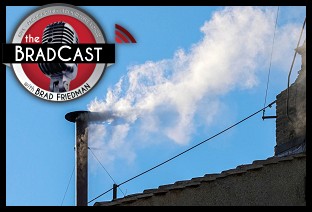 Blowing Smoke. At the Vatican and White House: 'BradCast' 5/8/25
Blowing Smoke. At the Vatican and White House: 'BradCast' 5/8/25 'Green News Report' 5/8/25
'Green News Report' 5/8/25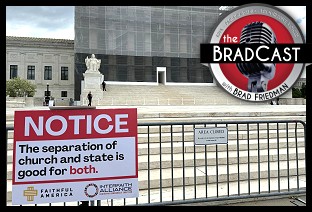 SCOTUS Weighs Public Funding of Religious Schools: 'BradCast' 5/7/25
SCOTUS Weighs Public Funding of Religious Schools: 'BradCast' 5/7/25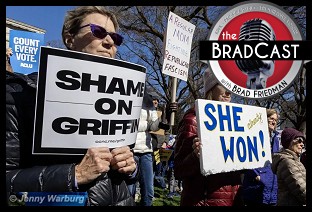 Trump Judge Blocks NC GOP Theft of 2024 Supreme Court Seat: 'BradCast' 5/6/25
Trump Judge Blocks NC GOP Theft of 2024 Supreme Court Seat: 'BradCast' 5/6/25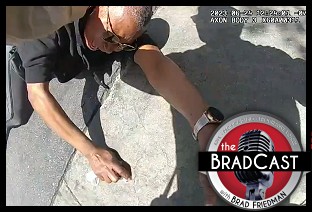 Prosecutors Quit After U.S Attny Strikes Deal With Felon Cop: 'BradCast' 5/5/25
Prosecutors Quit After U.S Attny Strikes Deal With Felon Cop: 'BradCast' 5/5/25 Trump Losing Streak Continues into SECOND Hundred Days: 'BradCast' 5/1/25
Trump Losing Streak Continues into SECOND Hundred Days: 'BradCast' 5/1/25 100 Daze (w/ Digby and Driftglass): 'BradCast' 4/30/25
100 Daze (w/ Digby and Driftglass): 'BradCast' 4/30/25 Campaign to 'Impeach Trump Again' Gains Fresh Momentum: 'BradCast' 4/29/25
Campaign to 'Impeach Trump Again' Gains Fresh Momentum: 'BradCast' 4/29/25 And Then They Came for the Judges...: 'BradCast' 4/28/25
And Then They Came for the Judges...: 'BradCast' 4/28/25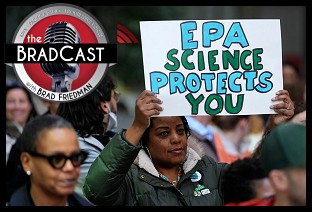 Trump EPA Guts Enviro Justice Office: 'BradCast' 4/24/25
Trump EPA Guts Enviro Justice Office: 'BradCast' 4/24/25
 VA GOP VOTER REG FRAUDSTER OFF HOOK
VA GOP VOTER REG FRAUDSTER OFF HOOK Criminal GOP Voter Registration Fraud Probe Expanding in VA
Criminal GOP Voter Registration Fraud Probe Expanding in VA DOJ PROBE SOUGHT AFTER VA ARREST
DOJ PROBE SOUGHT AFTER VA ARREST Arrest in VA: GOP Voter Reg Scandal Widens
Arrest in VA: GOP Voter Reg Scandal Widens ALL TOGETHER: ROVE, SPROUL, KOCHS, RNC
ALL TOGETHER: ROVE, SPROUL, KOCHS, RNC LATimes: RNC's 'Fired' Sproul Working for Repubs in 'as Many as 30 States'
LATimes: RNC's 'Fired' Sproul Working for Repubs in 'as Many as 30 States' 'Fired' Sproul Group 'Cloned', Still Working for Republicans in At Least 10 States
'Fired' Sproul Group 'Cloned', Still Working for Republicans in At Least 10 States FINALLY: FOX ON GOP REG FRAUD SCANDAL
FINALLY: FOX ON GOP REG FRAUD SCANDAL COLORADO FOLLOWS FLORIDA WITH GOP CRIMINAL INVESTIGATION
COLORADO FOLLOWS FLORIDA WITH GOP CRIMINAL INVESTIGATION CRIMINAL PROBE LAUNCHED INTO GOP VOTER REGISTRATION FRAUD SCANDAL IN FL
CRIMINAL PROBE LAUNCHED INTO GOP VOTER REGISTRATION FRAUD SCANDAL IN FL Brad Breaks PA Photo ID & GOP Registration Fraud Scandal News on Hartmann TV
Brad Breaks PA Photo ID & GOP Registration Fraud Scandal News on Hartmann TV  CAUGHT ON TAPE: COORDINATED NATIONWIDE GOP VOTER REG SCAM
CAUGHT ON TAPE: COORDINATED NATIONWIDE GOP VOTER REG SCAM CRIMINAL ELECTION FRAUD COMPLAINT FILED AGAINST GOP 'FRAUD' FIRM
CRIMINAL ELECTION FRAUD COMPLAINT FILED AGAINST GOP 'FRAUD' FIRM RICK SCOTT GETS ROLLED IN GOP REGISTRATION FRAUD SCANDAL
RICK SCOTT GETS ROLLED IN GOP REGISTRATION FRAUD SCANDAL VIDEO: Brad Breaks GOP Reg Fraud Scandal on Hartmann TV
VIDEO: Brad Breaks GOP Reg Fraud Scandal on Hartmann TV RNC FIRES NATIONAL VOTER REGISTRATION FIRM FOR FRAUD
RNC FIRES NATIONAL VOTER REGISTRATION FIRM FOR FRAUD EXCLUSIVE: Intvw w/ FL Official Who First Discovered GOP Reg Fraud
EXCLUSIVE: Intvw w/ FL Official Who First Discovered GOP Reg Fraud GOP REGISTRATION FRAUD FOUND IN FL
GOP REGISTRATION FRAUD FOUND IN FL

































